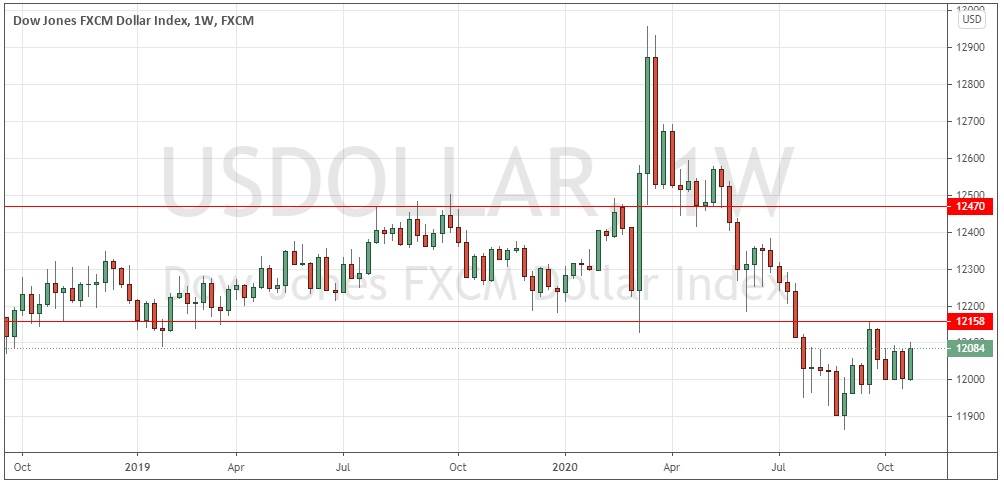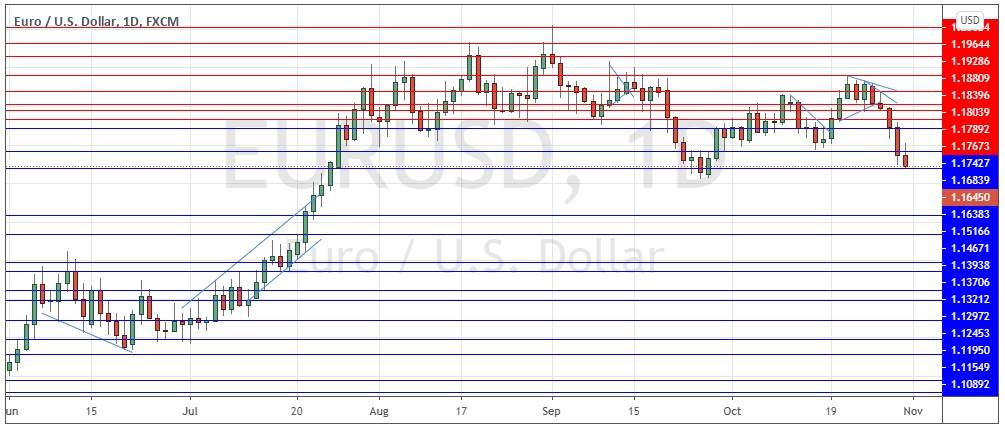The difference between success and failure in Forex trading is very likely to depend mostly upon which currency pairs you choose to trade each week and in which direction, and not on the exact trading methods you might use to determine trade entries and exits. The current market environment remains one of contradiction, with a questionable rebound as global stock market indices recovered to reach new all-time highs before correcting, despite the continuing spread of the coronavirus pandemic which is still sweeping the world.
Big Picture 1st November 2020
In my previous piece last week, I saw the most attractive trade opportunities as likely to be in short-term short trades in the USD/JPY currency pair below 104.37. This was not such a great call as the USD/JPY currency pair ended the week above 104.37 after sending some time below that level.
Last week’s Forex market saw the strongest rise in the relative value of the U.S. Dollar and the strongest fall in the relative value of the Euro.
Fundamental Analysis & Market Sentiment
Markets appear to be largely unconcerned with the result of the U.S. Presidential election, having already priced in a likely Biden victory (estimated by betting markets at a 64% probability) which is forecast by almost all major opinion pollsters. Nationwide polls are showing Biden ahead by almost 8%, while in the key swing states he is ahead by about 3%. Some analysts take a contrarian view that the polls severely underestimate the President’s support and the polls have certainly showed a gain for Trump over the past two weeks.
Some analysts believe that the prospect of a Democrat sweep of the Presidency and Congress would be likely to boost stocks on hopes it would make a big stimulus package more likely.
The big coronavirus story right now is the sharp rise in deaths globally plus the high level of new confirmed cases in Europe and the United States, although the situation is worse in Europe. Several European nations are reporting all-time high levels of new cases, while deaths are rising also. This is leading several European countries to again impose lockdowns aimed at slowing the spread of the virus, most notably France, Germany, and England. The European Union is now reporting more daily cases and deaths than any single country. New cases are also rising strongly in the U.S.A. to hit new all-time highs.
There seems to be little doubt the new European lockdowns are hitting the value of the Euro, which is close to hitting long-term low prices against the U.S. Dollar and the Japanese Yen.
It is becoming clearer that globally, the amount of new confirmed coronavirus cases is increasing exponentially. Last Friday saw a new record high daily tally, with 573,694 confirmed cases reported.
The U.S. stock market fell strongly last week, making its second-strongest weekly fall since last March.
Yesterday saw the highest daily coronavirus death toll worldwide in the U.S.A., at approximately 900 deaths.
The United Kingdom and Colombia have each confirmed a total of more than 1 million coronavirus cases.
Latin America is responsible for approximately 25% of confirmed new daily deaths, with the U.S.A. at 17% and Europe (including the U.K.) at about 31%. The strongest growth in new confirmed cases is happening in Algeria, Armenia, Austria, Azerbaijan, Belarus, Belgium, Belize, Bosnia, Bulgaria, Canada, Colombia, Costa Rica, Croatia, Cuba, Cyprus, Czech Republic, Denmark, Estonia, Finland, Georgia, Germany, Greece, Hungary, Iceland, Iran, Italy, Japan, Jordan, Kenya, Kosovo, Latvia, Lebanon, Liechtenstein, Lithuania, Moldova, Montenegro, Morocco, Netherlands, North Macedonia, Norway, Poland, Portugal, Romania, Russia, Serbia, Slovakia, Slovenia, Sri Lanka, Sweden, Switzerland, Turkey, U.S.A., Ukraine, the United Kingdom and Uruguay.
The coming week is likely to bring a considerably higher level of activity in the Forex market than what was seen last week. In addition to the U.S. Presidential election, we will be getting central bank input from the Federal Reserve and the Bank of England, plus non-farm payrolls data from the U.S.A. at the end of the week.
The U.S. stock market typically rises after a U.S. Presidential election. However, any such effect may be delayed this year, as it may well take several days before the final result will become clear due to the large number of mailed-in votes.
Technical Analysis
U.S. Dollar Index
The weekly price chart below shows the U.S. Dollar index printed a bullish engulfing candlestick. It closed quite near the top of its range, which is a bullish sign. Significantly, the long-term bearish trend is signaling its end, as the price is now higher than it was 3 months ago. Overall, next week’s price movement in the U.S. Dollar looks slightly likely to be upwards, but this is a difficult call, and the price is anyway potentially capped by the resistance level nearby at 12158.
EUR/USD
The EUR.USD currency pair is in a long-term downwards trend after falling strongly last week, printing a strong weekly bearish candlestick which closed right on the low of its range. The Dollar itself is no longer in a downwards trend while the Euro is weakening due to soaring coronavirus cases and new lockdowns in the Eurozone. A further fall over the coming week is quite likely than not to happen. The problem with shorting this currency pair is that the price has still not made a daily close below the low at 1.1627, so it would be wise to see a daily (New York) close below that level before entering a new short trade.
Bottom Line
I see the best likely opportunities in the financial markets this week in looking for a short trade in the EUR/USD currency pair below 1.1627.


